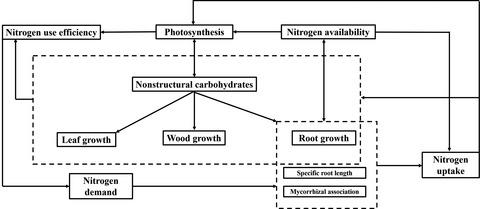Our official English website, www.x-mol.net, welcomes your feedback! (Note: you will need to create a separate account there.)
Magnitude and mechanisms of nitrogen-mediated responses of tree biomass production to elevated CO2: A global synthesis
Journal of Ecology ( IF 5.5 ) Pub Date : 2021-08-25 , DOI: 10.1111/1365-2745.13774 Zhaoguo Wang 1, 2 , Chuankuan Wang 1, 2
中文翻译:

树木生物质生产对二氧化碳升高的氮介导反应的幅度和机制:全球综合
更新日期:2021-08-25
Journal of Ecology ( IF 5.5 ) Pub Date : 2021-08-25 , DOI: 10.1111/1365-2745.13774 Zhaoguo Wang 1, 2 , Chuankuan Wang 1, 2
Affiliation

|
- Elevated atmospheric CO2 concentration (eCO2) typically stimulates tree growth, which is mediated by nitrogen (N) availability; but how N regulates tree biomass responses to eCO2 remains uncertain, which limits our prediction of forest carbon (C) cycling under future global change scenarios.
- A meta-analysis of a global dataset including 3,399 observations from 283 papers published from 1980s to February 2021 was conducted with the aim of elucidating N-mediated responses of tree biomass production to eCO2 and the underlying mechanisms.
- We found that eCO2 stimulated tree biomass production (+32.0%), while it induced accumulation of non-structural carbohydrates in leaves rather than in woods and roots, suggesting that the production may be C-limited but depend on the sink strength of organs. Biomass responses to eCO2 of N-fertilized trees (+39.6%) were 68.4% greater than those of non-fertilized trees (+23.5%), confirming that tree growth is also N-limited. Such N limitation was alleviated by the eCO2-induced increases in N uptake and N-use efficiency (NUE), with the former being more important. Increases in tree N pool arose from the enhanced production of fine roots with a lower specific root length, whereas increases in NUE resulted from the flexibility in tissue C:N ratios instead of N resorption efficiency. The positive responses of tree biomass production to eCO2 were greater for ectomycorrhizal trees and conifers than for arbuscular mycorrhizal trees and angiosperms, respectively.
- Synthesis. Our findings suggest that eCO2 stimulates tree biomass production by increasing C availability, and alleviating N limitation in a feedback way via enhancing N uptake and NUE, and they improve our mechanistic understanding of responses of forest productivity and C sequestration to eCO2 under global change.
中文翻译:

树木生物质生产对二氧化碳升高的氮介导反应的幅度和机制:全球综合
- 大气 CO 2浓度 (eCO 2 )升高通常会刺激树木生长,这是由氮 (N) 可用性介导的;但 N 如何调节树木生物量对 eCO 2 的反应仍不确定,这限制了我们对未来全球变化情景下森林碳 (C) 循环的预测。
- 对全球数据集进行了荟萃分析,其中包括 1980 年代至 2021 年 2 月发表的 283 篇论文中的 3,399 项观察结果,目的是阐明 N 介导的树木生物量生产对 eCO 2 的响应及其潜在机制。
- 我们发现 eCO 2刺激了树木生物量的产生 (+32.0%),同时它诱导了非结构性碳水化合物在叶子中而不是在木材和根中的积累,这表明该产生可能受到 C 限制,但取决于器官的库强度. 施氮树木 (+39.6%)对 eCO 2的生物量响应比未施肥树木 (+23.5%) 高 68.4%,证实树木生长也受氮限制。eCO 2缓解了这种氮限制诱导氮吸收和氮利用效率 (NUE) 的增加,前者更为重要。树木 N 库的增加是由于细根的产量增加而具有较低的比根长度,而 NUE 的增加是由于组织 C:N 比率的灵活性而不是 N 吸收效率。外生菌根树和针叶树的树木生物量生产对 eCO 2的积极响应分别大于丛枝菌根树和被子植物。
- 合成。我们的研究结果表明,eCO 2通过增加碳的可用性来刺激树木生物量生产,并通过增强氮吸收和 NUE 以反馈方式缓解氮限制,并且它们提高了我们对全球变化下森林生产力和碳固存对 eCO 2的响应的机制理解.


























 京公网安备 11010802027423号
京公网安备 11010802027423号